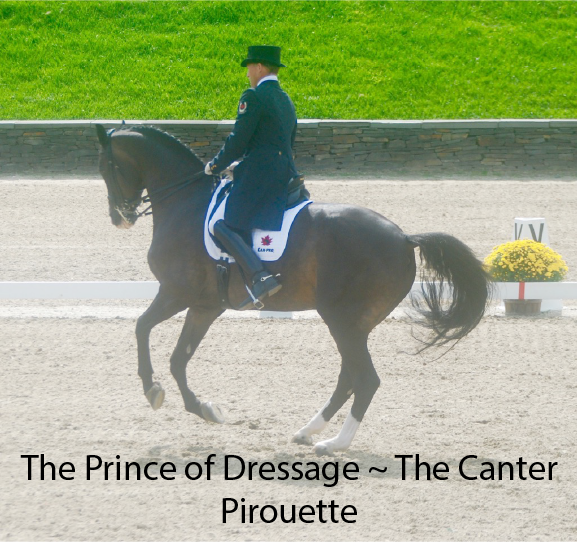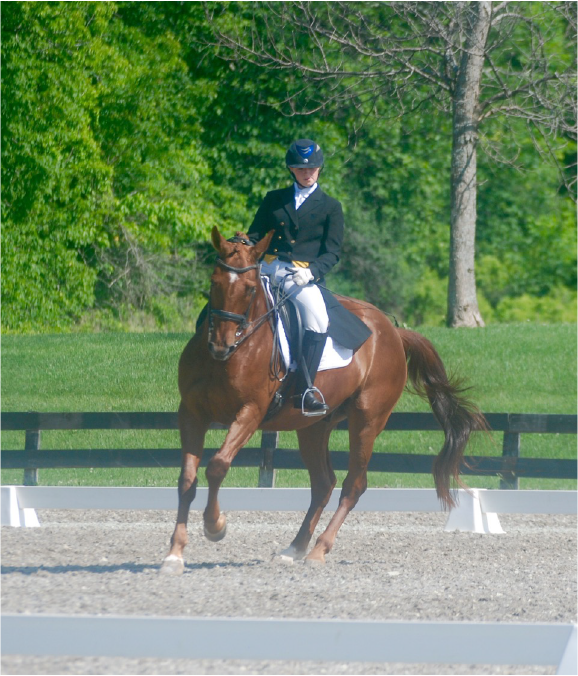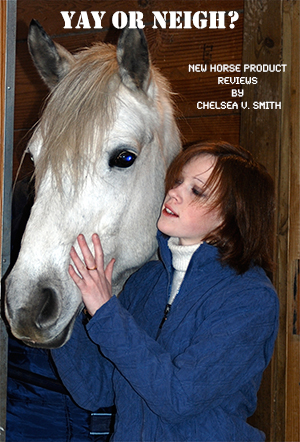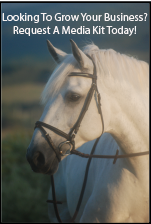The Prince of Dressage ~ The Canter Pirouette
By Nikki Alvin-Smith

Mastering the canter pirouette is not as hard as you may think. Like any dressage movement it simply requires correct preparation.
The iconic Carl Hester teaches it saying you need two things; a good walk pirouette and a canter on the spot. While that is essentially true, there are a variety of components that must also be in place and not assumed.
The walk pirouette is introduced in the basic training of the horse and it should be fairly straightforward to attain if you have trained your horse to move away from a tapping leg aid. For the purposes of training the walk pirouette the horse must start with an understanding of moving away from the leg sideways and this is best accomplished by training the horse to do a turn on the forehand in hand, and then in the saddle. As a classical dressage aficionado I realize the inclusion of a turn on the forehand training in the classical world is not acceptable. However, it is so very useful in the baby stages of walk pirouette. This is the only time I utilize it and it is briefly used and then transitions quickly to the walk pirouette so is discarded from training.
To begin the walk pirouette your horse must have an elevated and athletic collected walk. As this article discusses the canter pirouette we will assume you have mastered the walk variety.
It is paramount that your horse responds promptly to very light aids before you begin the task of schooling the canter pirouette.
The quality of the canter and your ability of the horse to remain completely straight, even in both reins and accept the collecting half halts through his entire body are prerequisites for training the canter on the spot. Exercises to accomplish this are found in the training scale and the horse must be able to come back to the rider without changing tempo but by elevating the gait. The horse must hop and maintain the purity of the canter and the energy and rhythm.
To canter on the spot the rider should begin by sitting deep and using half halts. These half halts should be light and slightly upward in direction. It is often useful to begin with counter canter when asking for the horse to come back to you as the wall will aid in him thinking to come back and helps prevent him throwing his haunches away to avoid the collection. In no event should the rider pull backward on the rein. In the canter pirouette the horse must approach the exercise with energy and ‘pop’ and must not be slowed down to such a degree he falters. To begin a shortening of the stride should be rewarded by sending the horse forward right afterward. It is imperative that the horse moves promptly forward for a few strides.
You should be able to work from collected canter, to halt, to collected canter on a straight line. The horse must lift himself promptly off your leg aids and stay light in the bridle throughout. As in all dressage you are always working your horse to his own cadence (please refer to previous article in Horse Bits magazine for more information on this topic).
You can incorporate the rein back in your schooling to test the connection through the rein and to encourage development of your horse’s core and use of his topline and to improve his ability to step forward from behind. This will build strength for carrying power and also develop the gaskin muscles to improve his ability to sit.
The canter half pass must be well schooled, hence the horse will have the important ability to exact haunches in accurately, without tension and without throwing his haunches to the inside too far as an evasion. If your horse has a tendency to do this simply counter flex his neck for a stride so he is listening to the leg aids.
A great exercise to test if your horse is ready to undertake the canter pirouette is to work in travers and then renvers on a circle. Begin this exercise at a walk and complete both exercises on both reins. If you can maintain correct bend around your inside leg from one exercise through a straight stride on the circle to the other with ease then the next step will be easier.
Some trainers like to begin the schooling for the two track pirouette from work on the long side. Begin this exercise at the walk before the canter. As you reach the short side you position your horse with haunches in as you approach the turn and ask the horse to come back to you (collect) and shorten but elevate his stride. As you reach the actual corner hold your horse in haunches in and position his shoulders to shoulder in. His haunches must not lead him around the corner which the rider prevents by holding the inside leg position but being active in the outside leg aid. Some riders and horses find the use of the corner of the arena helpful as the horse naturally wishes to turn.
However, personally I find it easier to work from an ever diminishing square as I have found most horses find it easier to learn to take more weight on their inside hind leg this way, and to transition from a half pirouette (180 degree turn) to a full pirouette (360 degree turn).
You start with a large square and ride the canter in a light travers position. Gradually you make the square smaller, being certain that the poll remains the highest point of the horse and that the horse is light in the reins. From this exercise you can request a half pirouette.
Once this is achieved you can complete the same exercise on the half volte and then on a circle. The ever-diminishing circle should be once again completed in travers. As the weight carrying inside hind leg becomes more engaged the horse may slow or falter. If this happens ride him briskly forward in a straight line out of the circle.
 It is also possible to train the canter pirouette from the walk. This method is especially useful for horses that have difficulty with their balance. I have used this method very successfully with horses that are hot or excitable and who tend to over-think their training and try too hard and second guess their rider and start their effort in a movement too early. A few steps of walk pirouette are followed by the aid to canter with minimal aids. Canter for just two or three steps and then back to walk and praise your horse.
It is also possible to train the canter pirouette from the walk. This method is especially useful for horses that have difficulty with their balance. I have used this method very successfully with horses that are hot or excitable and who tend to over-think their training and try too hard and second guess their rider and start their effort in a movement too early. A few steps of walk pirouette are followed by the aid to canter with minimal aids. Canter for just two or three steps and then back to walk and praise your horse.
As with any new exercise do not over-school it and especially in the early stages be content and be sure to reward any effort the horse makes to complete the task.
The rider turns their shoulders to match the horse and look between the horse’s ears. Some trainers advocate looking to the side in the direction of travel. The most important thing is to keep your head up and neck and eyes soft. Your outside rein is giving light frequent half halts and the inside rein is showing the direction but not holding. Your outside leg is tapping behind the girth and the inside one is tapping on the girth to maintain impulsion.
The rider must not allow their seat to move to the outside of the horse or to slide back in the saddle. As in the walk pirouette the rider may take slightly more weight to the inside seat bone but this should occur naturally as a result of the horse’s movement and not be forced by the rider. Some trainers also suggest the rider drops the inside shoulder during the turn. I do not advocate this. The rider should be responsible for maintaining their position and not resort to affectations. If the rider forces the turn, the horse will simply be pulled around by the inside rein and his forward energy blocked by too much pressure on the outside rein. Hands must always yield and not hold.
Remember you are not looking for the inside hind hoof to describe a tiny dinner plate circle when you begin. You should be satisfied with the horse staying in his true canter rhythm, describing a generous circle to begin with is fine and you don’t want his hind feet to become stuck together.
In the canter pirouette as in the walk pirouette the most common mistakes are to over flex the neck, which will block the forward energy and to lose the energy in the gait. You are asking for a bend in the poll to begin the exercise and the flexion should be slight to the inside. The horse’s nose should be slightly in front of the vertical.
If your horse cannot execute a calm and correct walk pirouette from one side to the other then you are not ready to move to the canter in this exercise. It is also important to remember that the half pirouette exercise should be a horse’s width between the straight line of arrival and departure from the movement. Do not try to shuffle your horse back onto the same line on departure in a half pass movement as this is incorrect and not the purpose of this movement.
If your horse becomes stuck in the canter pirouette then work on the quality of the canter by improving transitions between medium and collected, medium and extended. The horse should work on minimal light aids at this stage in his career. Remember it is always the release of the rein that provides the collection not the taking of the half halt. The successful learning and execution of the three ‘P’s of dressage, the canter pirouette, the piaffe and passage, depend upon mastering the attribute of lightness and prompt attention to the aids.
You should school the full pirouette from a straight line across a diagonal and exit the pirouette in a straight line in a normally cadenced canter. This is important for the quality of the flying change which comes after the pirouette in the tests, and which in some tests is scored together with the canter pirouette.
Happy riding!
About the author: Nikki Alvin-Smith is an international Grand Prix dressage trainer/clinician who has competed in Europe at the Grand Prix level earning scores of over 72%. Together with her husband Paul, who is also a Grand Prix rider, they operate a private horse breeding/training farm in Stamford, NY.


